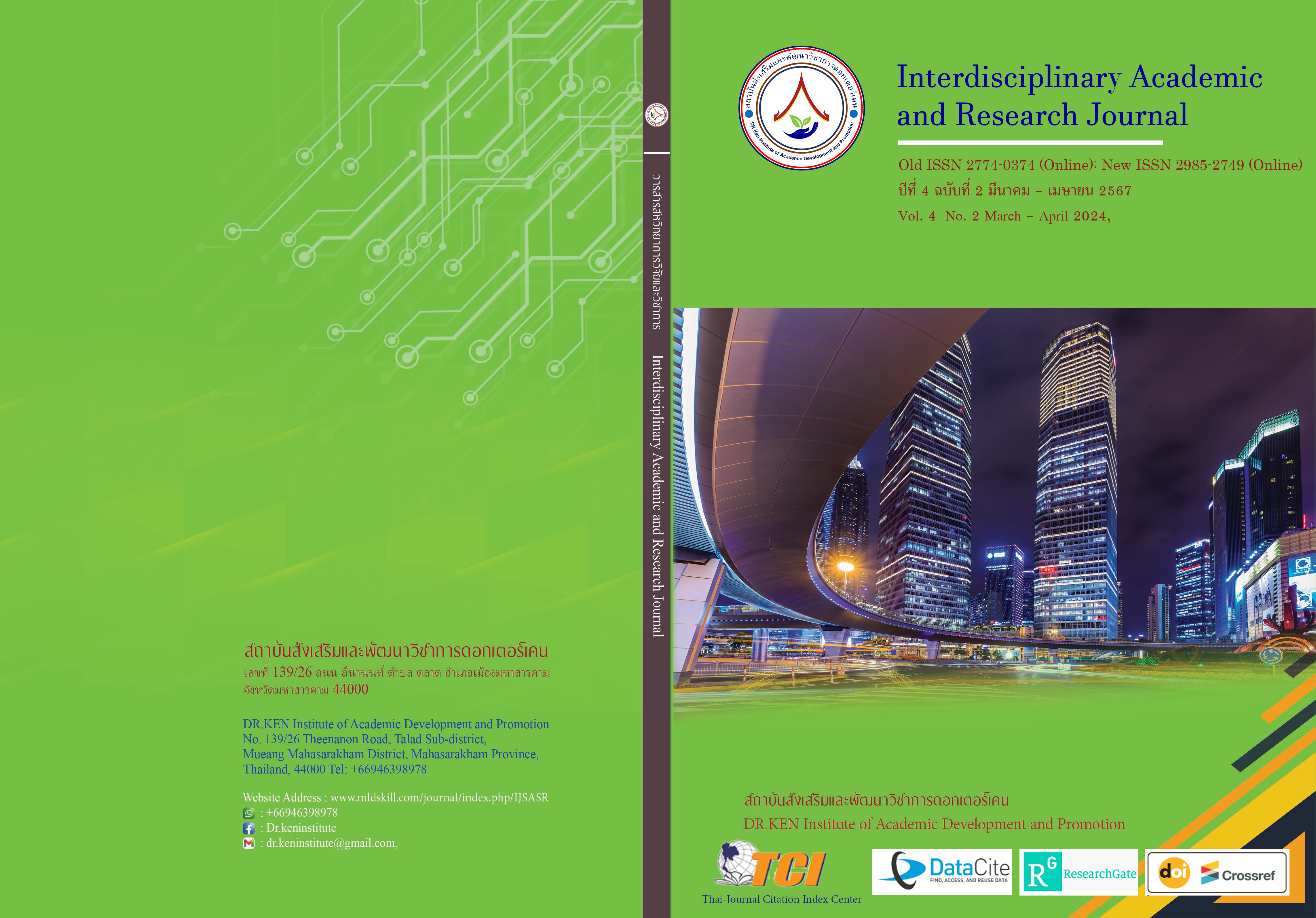Thai Supplementary Development on the Title of Thai Grammatical in Thai Curriculum for Mathayomsuksa 2
DOI:
https://doi.org/10.60027/iarj.2024.275097Keywords:
Development of Teaching; , Principle of Thai Language; , Academic AchievementAbstract
Background and Aims: This study aims: (1) to create and to find the proficiency. And (2) to compare the proficiency with the pretest and posttest on Thai supplementary development on the title of Thai Grammatical in Thai Curriculum for Mathayomsuksa 2 students, the semester 1 of the academic year of 2566. The 27 populations, randomized by purposive sampling for 1 classroom, were Mathayomsuksa 2 students, the semester 1 of an academic year of 2566.
Methodology: The instruments were 10 sets of Thai supplementary development on the title of Thai Grammatical in Thai Curriculum for Mathayomsuksa 2 students, the 40 items with Multiple Choice on achievement test. The statistical procedures employed to examine the data were Percentage, Mean, and Standard Deviation.
Results: The results of the study were the following: (1) Teaching set on principles of language use Thai language learning group For Mathayomsuksa 2 students, the efficiency was 84.19/82.40, higher than the set criteria. And (2) Thai supplementary development on the title of Thai Grammatical in Thai Curriculum for Mathayomsuksa 2 was statistically significantly different at level 0.01, accepted the hypothesis determination.
Conclusion: The study exceeded predetermined standards for Mathayomsuksa 2 students and showed the efficacy of teaching strategies based on language principles. Furthermore, the study's hypotheses are supported by the noteworthy enhancement in Thai grammatical understanding, which is supported by statistical significance at the 0.01 level. This validates the effectiveness of Thai supplementary development within the curriculum.
References
กระทรวงศึกษาธิการ. (2545). พระราชบัญญัติการศึกษาแห่งชาติ พุทธศักราช 2542 และแก้ไขเพิ่มเติม (ฉบับที่ 2) พุทธศักราช 2545. สำนักงานปลัดกระทรวงศึกษาธิการ.
กัลยวรรธน์ ฉันทจิตปรีชา. (2560). การพัฒนาชุดการสอน เรื่อง การสร้างคำในภาษาไทย สำหรับนักเรียนชั้นมัธยมศึกษาปีที่ 1. ปริญญานิพนธ์ : ราชภัฏนครสวรรค์.
เจษฎา บุญมาโฮม และคณะ. (2565). การพัฒนาผลสัมฤทธิ์ทางการเรียนวิชาภาษาไทย เรื่องการเขียนสะกดคำ ของนักเรียนชั้นมัธยมศึกษาปีที่ 1 โดยใช้แบบฝึกทักษะ. คุรุศาสตร์.มหาวิทยาลัยราชภัฏนครปฐม.
ธมลวรรณ โชติระโส. (2553). การสร้างชุดการสอนเพื่อพัฒนาการเขียนเรียงความ สำหรับนักเรียนชั้นประถมศึกษาปีที่ 5. วารสารปาริชาต, 23(1), 35-44.
ธัญญาดล อุปชิตกุล. (2559). การพัฒนาผลสัมฤทธิ์ทางการเรียนโดยใช้หนังสืออิเล็กทรอนิกส์ (E-books) เรื่อง หลักภาษาและการใช้ภาษา รายวิชาภาษาไทยพื้นฐาน (ท31102) กลุ่มสาระการเรียนรู้ภาษาไทย สำหรับนักเรียนชั้นมัธยมศึกษาปีที่ 4. สำนักงานคณะกรรมการการศึกษาขั้นพื้นฐาน กระทรวงศึกษาธิการ.
บุญชม ศรีสะอาด. (2560). การวิจัยเบื้องต้น. กรุงเทพฯ : สุวีริยาสาส์น.
ราชกิจจานุเบกษา. (2545). พระราชบัญญัติการศึกษาแห่งชาติ พ.ศ. 2542 ที่แก้ไขเพิ่มเติม (ฉบับที่ 2) พ.ศ. 2545. ฉบับกฤษฎีกา, 116 (ตอนที่ 74 ก).
สถาบันทดสอบทางการศึกษาแห่งชาติ. (2565). รายงานผลการทดสอบทางการศึกษา ระดับชาติขั้นพื้นฐาน (O-NET) ปีการศึกษา 2564. กรุงเทพฯ: สถาบันทดสอบทางการศึกษาแห่งชาติ.
สุคนธรัตน์ สวัสดิกูล, ศิริลักษณ์ อินทสโร และ เอกนุช ณ นคร. (2561). การเปรียบภาษาไทยมาตรฐานกับภาษาไทยถิ่นใต้ อำเภอทุ่งใหญ่ จังหวัดนครศรีธรรมราช. รายงานการวิจัย คณะวิทยาศาสตร์และเทคโนโลยี มหาวิทยาลัยเทคโนโลยีราชมงคลศรีวิชัย.
Brown, A., & Johnson, L. (2018). Multimedia learning: A cognitive load perspective. In J. E. Stone, M. M. Siti, A. M. Noor, & P. Y. Tso (Eds.), Multimedia tools and applications for environmental & cultural heritage information systems (pp. 43-61). IGI Global.
Clark, R. C., & Mayer, R. E. (2016). e-Learning and the science of instruction: Proven guidelines for consumers and designers of multimedia learning. John Wiley & Sons.
Johnson, L., Adams Becker, S., Cummins, M., Estrada V., Freeman, A., & Ludgate, H. (2019). NMC horizon report: 2019 higher education edition. EDUCAUSE.
Krejcie, R.V., & D.W. Morgan. (1970). Determining Sample Size for Research Activities. Educational and Psychological Measurement, 30(3), 607 – 610.
McKenzie, J., & Hone, L. C. (2021). Revisiting formative evaluation in educational technology design: An empirical study of the ADDIE framework. Educational Technology Research and Development, 69(2), 915-938.
Roberts, T. S., & Green, S. G. (2017). Integrating technology into teaching: A challenge for 21st century teachers. Journal of Technology and Teacher Education, 25(4), 413-437.
Smith, A. B., & Jones, C. D. (2020). Enhancing teaching and learning through instructional kits. Journal of Education, 42(3), 297-312.
Downloads
Published
How to Cite
Issue
Section
License
Copyright (c) 2024 Interdisciplinary Academic and Research Journal

This work is licensed under a Creative Commons Attribution-NonCommercial-NoDerivatives 4.0 International License.
Copyright on any article in the Interdisciplinary Academic and Research Journal is retained by the author(s) under the under the Creative Commons Attribution-NonCommercial-NoDerivatives 4.0 International License. Permission to use text, content, images, etc. of publication. Any user to read, download, copy, distribute, print, search, or link to the full texts of articles, crawl them for indexing, pass them as data to software, or use them for any other lawful purpose. But do not use it for commercial use or with the intent to benefit any business.
















.png)


